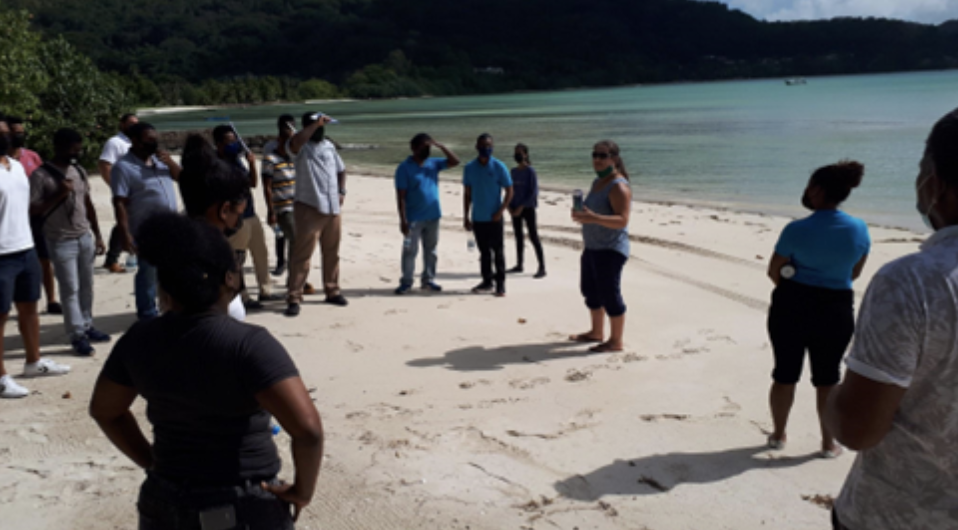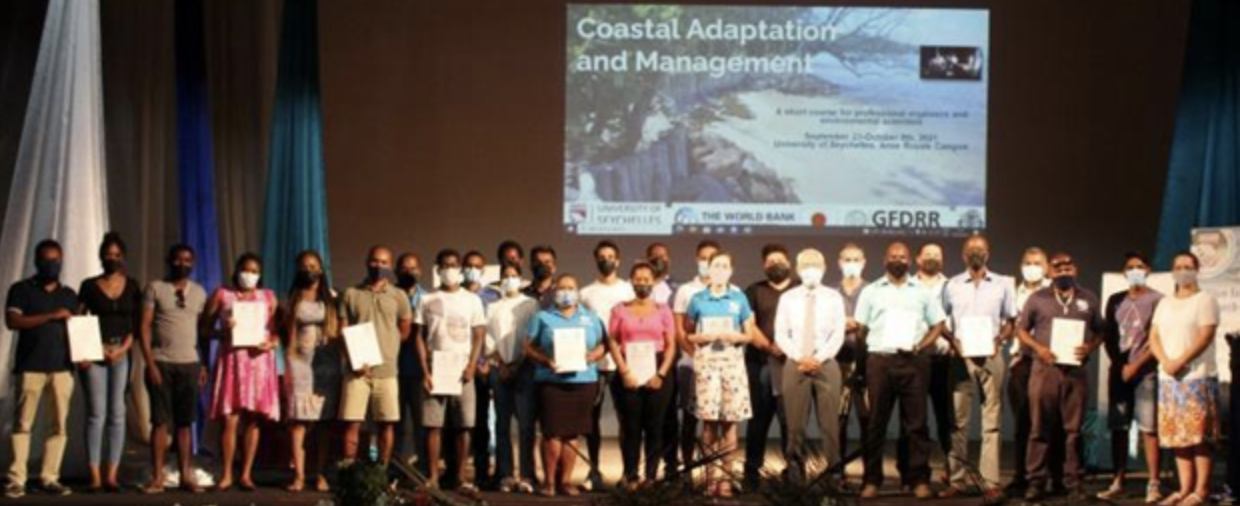Thirty professionals from diverse backgrounds form a circle on Anse la Mouche beach in the Indian Ocean archipelago of Seychelles, where a lively discussion on the effectiveness of measures to build resilient coasts is taking place.
Flooding and erosion are growing problems for low lying coastal zones across the world. Seychelles is no exception. The country, which is surrounded by coral reefs, has been at the forefront of this effort to improve resilience along its coasts. For decades, the default coastal protection measure has been coastal hardening, such as rock armoring and seawalls, but nature-based approaches that combine engineering with rehabilitating coral reef systems are representing a new tide of innovation in building coastal resilience while protecting natural capital.
These professionals discussing the future of Seychelles’ coastline are part of a six-day certificate course offered by the University of Seychelles with technical support from the World Bank, and funded by the Japan-World Bank Program for Mainstreaming Disaster Risk Management in Developing Countries managed by the Global Facility for Disaster Reduction and Recovery (GFDRR). Providing a venue for collaborative knowledge exchange and networking experience across sectors, the course helps build capacity to manage coastal risk management and breaks down silos.

Field trip to Anse La Mouche - discussions on the beach. Several coastal protection measures are in place at this site which has faced severe erosion. Photo credit: World Bank (Michele Martin)
The professional development course, held in October 2021, is also part of the Seychelles government’s commitment to build capacity for coastal resilience and to create opportunities for people to engage in research, dialogue and collaborative knowledge building, for the implementation of the National Coastal Management Plan (CMP) launched in 2019 with the support of the World Bank. An important priority in the CMP was the need for cross-sectoral coordination, knowledge, and technical capacity: engineers, conservation specialists and planners should work together for successful implementation.
The course was developed through a participatory process, led by the University of Seychelles with input from diverse government agencies representing the climate change, planning, infrastructure, land transport and disaster risk management sectors. The University of Seychelles coordinated the course delivery with local and international facilitators, providing the venue and leading field trips. Designed as a series of one-day modules over a month, the course allowed participants to balance professional development with their workload. Course modules focused on building knowledge in coastal management, coastal change processes, geospatial information systems, coastal protection measures, climate smart flood risk management, nature-based solutions, and linkages between climate resilient coastal management and the blue economy. Modules were delivered through a hybrid approach including both in-person and virtual lectures from local and international experts, allowing for cross-institutional dialogue, hands-on instruction, and field trips.
“As the course progressed it was very rewarding to see how participants started interacting and networking across their sectors (and outside their comfort zones),” said Dr. Nuette Gordon, the course coordinator for the University of Seychelles. The university has plans to replicate the course as well as integrate course materials into their graduate and undergraduate programs.
The course is built on the findings of technical studies conducted jointly by the World Bank and the government of Seychelles. The first was a study on coastal risks and preferred adaptation solutions for several erosion hotspots, which included a proposal for a Blue Barrier pilot project to simultaneously restore coral reefs and slow down coastal erosion. The second study provided an assessment of current and potential sources of funding for implementing Seychelles’ coastal management plan.

Course participants receiving their certificates in the presence of the representative of the Japanese Embassy. Photo credit: Seychelles Nation
The findings of both studies were presented in a stakeholder workshop in March 2022. This workshop attracted significant interest from the local media and strong participation from the government, the civil society and the private sector, including those who had attended the coastal management course. As a result, the government is rising to the challenge and actively looking for financing for innovative nature-based solutions proposed in the CMP, such as the Blue Barrier.
“At the end of the day, the success of Seychelles’ coastal resilience will be measured by the lives and the livelihoods we save. It takes everyone — communities, civil society groups, stakeholders representing key sectors, the government and donors — to come up with effective solutions,” said Keren Charles, a World Bank senior disaster risk management specialist who leads this technical assistance with Seychelles.
The need for strengthening institutions and cross-sectoral collaboration to enable the integration of NBS in planning and practice holds true in many other small island developing states and emerging market and developing economies. GFDRR’s Global Program on Nature-based Solutions for Climate Resilience is currently developing a modular course to replicate this approach in other country engagements.
